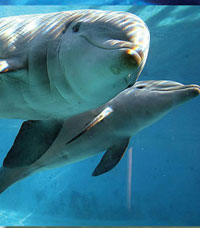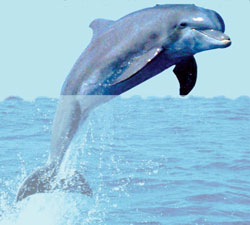|
Nature trail
Dolphins
Intelligent marine mammals
All animals except man know that the
ultimate of life is to enjoy it" - Samuel Butler 1912.
Today we feature yet another unique marine mammal which is facing
serious problems due to us humans. It is the lovable dolphin, a cousin
of the famous dolphin

named Flipper in the popular TV series which was telecast sometime
ago. Let's check out the lifestyle, habits, and physical features of
these cute-faced marine creatures who are known to be very intelligent
when compared to most other marine animals,These intelligent mammals are
found in our country too. There have been several reports of dolphins
being caught in the nets of our fishermen and being injured or killed,
eventually.
Dolphins belong to the family Delphinidae, which is the largest and
most diverse family of the cetacean order and include 26 living species.
Several species of dolphins are found in the Hawaiian waters. However,
it is not only in this area that they are found. Dolphins inhabit the
oceans worldwide, mostly in the shallower seas of the continental
shelves. The family Delphinidae is considered a relatively recent
addition to the cetacean family, having evolved more recently than the
others of its family. Most species of dolphins are larger than
porpoises, with the males usually being larger than the females.
The name is originally from the Ancient Greek word (delphs;
"dolphin"), which was related to the Greek word (delphys; "womb"). The
name can therefore be interpreted as meaning "a 'fish' with a womb.
Dolphins are extremely social creatures and they depend on their
social relations even while hunting as well as in reproduction. Unlike
the humpback whales and other species of baleen whales, dolphins live in
tightly knit groups - smaller groups are called pods which range between
two to forty members, and larger groups called schools or herds. These
groups can include more than one species, because each species has its
own niche. Spotted and Spinner dolphins are constantly found living in
such groups. Researchers believe that this is possible because spotted
dolphins usually prey on larger creatures closer to the surface, while
the Spinner dolphins tend to feed in deeper waters on smaller prey.
They are carnivores, maintaining a diet of mainly fish and squid.
Dolphins are some of the most intelligent animals, and their playful
behaviour and friendliness have made them very popular among humans.
Dolphins are adapted extremely well to the sea. Even though their
hind limbs have disappeared, their front limbs have developed into
flippers. Their powerful tail is the main instrument for them to move
forward. Dolphins possess a distinct beak. Their teeth are conical in
shape Dolphins usually breathe through what is called the blowhole on
the top of their heads. They can empty their lungs and refill them in
one fifth of a second. As they breathe, the air leaves the blowholes at
speeds of over 100mph. But how do they know when to open their
blowholes, because if they open them in the water, they could die?.
Well, as we know by now, all creatures are built with special features
needed to help them survive in the habitats they live in. So, dolphins
too have such special features and they know exactly when the surface is
near so that they could open their blowholes. Water in a dolphin's
blowhole will definitely drown it, therefore powerful muscles close the
blowhole as soon as it dives under the water after taking in a breath of
air.
 Its
eyes produce a slippery liquid which protects the dolphin from unknown
substances as well as the water. Like whales the dolphin can only sleep
with one brain resting at a time or else it can drown. Dolphins take
short cat-naps, floating just below the surface, and then slowly rising
to breathe, because breathing is a voluntary procedure for the
cetaceans. Often dolphins are very active during night time, and for
some, this is their main feeding time. Its
eyes produce a slippery liquid which protects the dolphin from unknown
substances as well as the water. Like whales the dolphin can only sleep
with one brain resting at a time or else it can drown. Dolphins take
short cat-naps, floating just below the surface, and then slowly rising
to breathe, because breathing is a voluntary procedure for the
cetaceans. Often dolphins are very active during night time, and for
some, this is their main feeding time.
The skin is completely smooth unlike that of most other mammals, and
this allows the dolphin to move faster in the water.

Their bodies are built in a way they could swim at high speeds
through the water, and an example of this is their ears. Dolphin's ears
are barely noticeable marked only by a small hole just behind the eye.
In a bottlenose dolphin, the ear is about 5-6 cms behind the eye and
only 2-3 mm in diameter.
Because dolphins feed on schools of prey, most species have developed
communal and cooperative hunting practices, as searching for food as a
group is more efficient than searching individually. The exception to
this rule is the river dolphin who usually feeds on individual prey on
the river bottom. They are often found living alone or in very small
groups.
Most dolphins move in groups that are wider than long. They do this
so that they can scan as large an area as possible, using their echo
location. The size of the groups may be determined by the number of
dolphins able to be sustained by the school of prey.
 Dolphins
and all species of whale use their exceptional hearing in an extremely
sophisticated manner, known as echolocation. This is when the animal
emits a variety of split-second "clicks" through its blowhole. The
"clicks" are pulses of ultrasonic sound (sounds repeated as rapidly as
800 times/second) produced in a dolphin's nasal passages and are focused
in a large, lens-shaped organ in the forehead known as the melon. The
melon focuses the sound on to a specific area. When the sound waves
bounce back in to the dolphins' path as it hits the object, the dolphins
can map its route and find its prey. Dolphins
and all species of whale use their exceptional hearing in an extremely
sophisticated manner, known as echolocation. This is when the animal
emits a variety of split-second "clicks" through its blowhole. The
"clicks" are pulses of ultrasonic sound (sounds repeated as rapidly as
800 times/second) produced in a dolphin's nasal passages and are focused
in a large, lens-shaped organ in the forehead known as the melon. The
melon focuses the sound on to a specific area. When the sound waves
bounce back in to the dolphins' path as it hits the object, the dolphins
can map its route and find its prey.
Using this amazing skill, a dolphin can create a picture of its
surroundings and can determine the size, shape, direction of movement
and distance of objects in the water. This allows the dolphin to hunt
over a wider range than their limited visibility normally allows.
Most groups of dolphins have strict hierarchical patterns, and there
are a few dominant members within the group. Large groups are often
mixed in terms of age and gender, but smaller groups are generally one
of three types: 1) A nuclear group that includes a single adult male and
female; 2) A nursery group, consisting of a number of females and their
young; 3) A bachelor group comprised of adult and younger males.
Regardless of the type, all groups of dolphins seem to have
well-developed skills in cooperating and working together as a team
whether it be for the purpose of finding food, mates or caring for their
young.
The maturing period varies with the species of dolphin in question,
however typically a calf is born every other year.
Dolphins are able to leap great distances, and the males frequently
do this to demonstrate how powerful they are to a female. Research
suggests that the average gestation period for a dolphin is round about
twelve months. Like the whale, dolphins too give birth to their calf,
tail first.

The newborns senses are fully developed and functioning. As soon as
it is born, the calf is nosed to the surface by its mother so that it
can breathe. The mother will stay with her calf for a period of two
years to sometimes even eight, and as in humans, the mother will nurse
her baby with milk and care for it till it can fend for itself.
Threats: Thousands of dolphins and small whales throughout the world
continue to be hunted for food, oil, fertiliser and other products. The
fishermen use boats and large nets to "drive" schools of dolphins into
shallow bays and harbours where they are killed, often brutally.
 The
meat is often sold for human or animal consumption, or made into
fertiliser. Japan is believed to be the largest consumer of dolphin.What
may turn out to pose the greatest threat to dolphins (and other marine
animals for that matter) is our contamination of the marine environment-
their home. The
meat is often sold for human or animal consumption, or made into
fertiliser. Japan is believed to be the largest consumer of dolphin.What
may turn out to pose the greatest threat to dolphins (and other marine
animals for that matter) is our contamination of the marine environment-
their home.
Pesticides, PCBs, heavy metals, plastic particles, and other
industrial wastes are released into our oceans, bays and rivers in
unknown amounts daily.
Many of these pollutants do not break down in the environment, or
take a very long time to do so. In addition, many dolphin deaths have
been attributed to swallowing man-made objects including balls, nets and
pieces of plastic.
***********
Fact file
* They are known to save humans in distress at sea.
* A group of dolphins is called a "school" or a "pod". Male dolphins
are called "bulls", females "cows" and young dolphins are called
"calves".
* Some types of dolphins must rise to the surface to breathe every 20
to 30 seconds.
* Each dolphin has its own signature whistle to identify itself.
* Five specific species live in fresh water; they are usually named
after the river they swim in such as the Amazon, the Yangzi Jiang, or
the Ganges.
*Dolphins seems to enjoy playing games with humans; they invent them
if you don't.
* Males can whistle to get the attention of females or to warn the
group of imminent danger.
* Cetaceans can taste, but have no sense of smell.
************
-Salindri PERERA |

